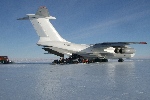
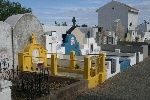
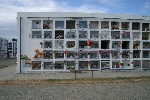
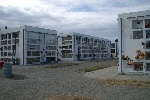
Going south.
No, make that: Going South.
All the way. Until there is no more south left.
It feels rather strange now. Two years ago, I was in New Zealand and went to the Antarctic Center in Christchurch. And I stood there, watching the Hercules plane at the airport, bound for McMurdo and the South Pole and I knew that this would be as close to the South Pole as I was ever going to get. And I left very depressed.
Little did I know that less than two years later, I would actually be standing at the South Pole and having the best journey of my life. A lifelong dream has come true.
Getting there took about a year of decision making, preparation and worries. Which is kind of boring and distracts from the actual journey and the fun parts, so I don't want to start the web page about going to the South Pole with this. If you want to read the whining and dull background story bits, go here. If you want to know about the trip itself, just continue reading.
For tourists, the trip to the South Pole starts in Punta Arenas, Chile. (People actually working at the South Pole usually get there via Christchurch, New Zealand.) Getting there was reasonably easy, going via Madrid and Santiago. Nice, calm flight, window seats on all parts of the flights, not much to do. (Less to do than expected, as a matter of fact. I assumed that all modern long-haul aircrafts have these individual screens in the back of the seats and multiple videos and games to select. Especially on a 13 hour flight. In their brochure, LAN Chile specifically mentions that feature of their new economy class. Too bad that it was an Iberia flight, just code-sharing with LAN Chile, so it turned out to be an airplane with just big monitors hanging from the ceiling in the middle row (not even multiple LCD screens in the side seat ceilings. So no choice in entertainment, just fixed movies. Which was especially dull, since I usually can't sleep on planes. [I found out on this journey that I can sleep on planes in some cases, but in circumstances that aren't going to come up often.]
Nice views of the Andes though, during the last hour before reaching Santiago.

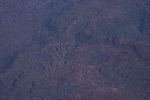
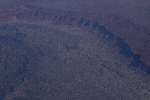
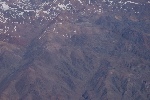
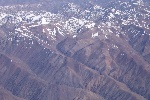
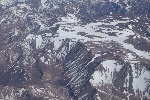
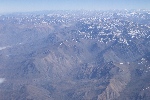
Missed my connecting flight in Santiago (had two hours to make it, but the plane was nearly an hour late and passport control and immigration had long, slow moving queues, so I only made it to the departure gate five minutes to departure, when the flight was already closed). Plane still standing there, but no way to board. Luckily, Santiago to Punta Arenas is a pretty busy route, so I managed to get into a flight about two hours later. No harm done.
Find out later, during the introduction briefing, that Iberia/LAN Chile Madrid-Santiago is almost always a problem. Missed connections, lost luggage. If something happens, it's on that trip. So I feel I got off lightly.
Got to Punta Arenas, checked into the hotel around 8 pm, feeling very tired, being up and about for nearly two days now, having spent 20+ hours in airplanes. Called ANI that I had finally arrived. "Great," they said, "we'll come over and check your gear, then you come over and get your rental gear." (While there was a long list of equipment that you are supposed to bring for your trip to Antarctica, there is some pretty specialized stuff, that you can seldom use outside Antarctica and which you rent for the trip, unless you go there really often. Stuff like sleeping bags rated to -40°C (-40°F) or shoes rated to -100°C (-148°F).) Was about 10 pm when I was back in my hotel room. Didn't have any problems going to sleep...
Next day had an info meeting at 10 am. Time to meet the other travellers. Most of them were climbers, going to climb Mt.Vinson (highest mountain in Antarctica). Basically there were 26 climbers, two people doing the 'Last Degree' (being flown by plane to 89°S and going the final 60 miles by skis, pulling sledges), one who would go to the South Pole later (his son was on the 'Last Degree' trip and he was going to go to the South Pole when he got there) and five of us for the South Pole trip.
Introduction was mainly a slide show with anecdotes. The message brought home was clear: ANI is a company that is essentially a ridiculous endeavour. Doesn't make sense. Shouldn't work. Shouldn't be able to exist. Doing a very good job to go on anyway. Welcome.
While it's clearly more professional and better organized than a decade ago, Michael Palin's quote "I've met my fellow passengers. As far as I can tell, not a sane one among them." still holds mostly true. And holds true for the people at ANI as well. (Can you somehow already tell that I liked the company?)
Everyone who had been to Antarctica and put up a web page writes of delays due to weather conditions. Our chances of getting there soon seem to be reasonably good. Weather has been marginal at Patriot Hills in the last couple of days, but has been improving. Currently the Ilyushin cargo plane (which I already glimpsed for a moment at the airport) is loaded for a fuel flight (barrels of fuel for the Twin Otters will be flown in, no passengers), which has been on the schedule for some time now, but never happened. But if weather conditions remain good, the fuel barrels will be dumped once again and our gear will be put on board and we will fly tomorrow as scheduled. Passenger trips have precedence. Looks like we're going to be lucky. Earlier the season, a group of people had to wait for two weeks before being able to go to Antarctica.
Afternoon is mostly free. We have to pack our polar gear (everything we don't need in Punta Arenas or on the flight) to have it collected at 4:15 pm, so it can be put on the plane whenever needed to.
Too bad. I was sort of interested in going to the penguin colony at Magdalena Island, but that one leave at 4 pm. So I decide to go to the statue of Magellan, which dominate the main square. According to tradition, rubbing the feet of one of the statues will ensure safe return to Punta Arenas. But the square is crowded and I feel silly doing that. Decide to postpone it to a time when it's less crowded.
So I go to the cemetery instead. Usually not a likely tourist attraction, but this one is strange. It has got big, tree lined alleys, ornate mausoleums, colourful graves, which I immediately dub Lego tombs and apartment block buildings for urns, complete with library-style movable ladders. It's an odd place. Cemeteries usually are, but this one even more so. It's also oddly un-creepy. Hard to imagine a zombie film here.
While walking through Punta Arenas, I notice two odd things. One is the garbage collection system. Most places have garbage cans somewhere at the back of the houses, only to be rolled out on garbage collection day. Here, there are fixed garbage receptacles on the side of the street, into which the garbage bags are placed. Quite convenient for collection, but it seems strange to have garbage displayed like this.
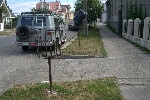
The other thing is next to the harbour. They got a fake whale fluke there. Can't figure out any reason why.
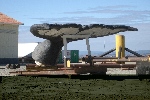
Next day at 9:30 am comes the update phone call from ANI. Weather conditions are very good at Patriot Hills and look stable, so they sent out the Ilyushin for the fuel flight last night. It just got back two hours ago and the crew needs the required rest. But unless weather worsens considerably, we'll fly in this evening. Time to go out, find an Internet cafe, write a couple of e-mails. Act silly. With fewer people around.

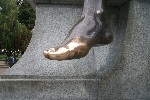

Afternoon call: It's a go. Get dressed in full polar gear. Be ready in 30 minutes. (Being dressed in full polar gear is required on the plane, in case that there is an emergency landing in the middle of nowhere. Supposedly. There is also a demonstration of life jackets on the plane, in case we have to do an emergency landing on water. As we've been told in the briefing: "Yes, there are life jackets. But if you go down in water in the Antarctic, you probably better grab a heavy metal toolbox before jumping out if the plane." This is going to be an interesting flight...)
Time for a quick remark about the clothing. A full set turns out to be quite a lot. What looks like the gear for a three week vacation is just one set of clothes.
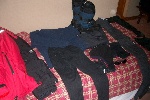

Going through the list: Underwear (not required, since the thermals are essentially underwear, but
since there are now real showering facilities in Punta Arenas, you spend a lot of time in the
thermals and it's a good idea to have underwear that you can change under that), thermal base layer,
fleece trousers and sweater, down trousers and parker, socks (I had very warm socks with me, but
with the polar boots, normal socks were more than sufficient - these boots are very good at keeping
the warmth in), polar boots, neck gaiter, headgear, glacier sunglasses, liner gloves, thick mittens.
Worn, it looks like that:
(We could wear normal hiking boots on the plane, as long as the polar boots were part of
the hand luggage. That's why I don't wear them in the picture.)

Time to go. When we get out to the airport we have to go through security and passport control. Quite silly, actually. While we get through metal detectors, which are very sensitive. (I know I didn't carry any metal items, but the detector kept ringing. Turned out that the metal rings through which the shoelaces go were enough metal to set it off.) But our hand luggage remains in the bus, which is driven to the Ilyushin. Without any checks. I make a remark to one of the ANI people about that. "Welcome to South America! But don't knock it, it works in our favour."
Then, filing along the loading ramp, we got into the plane. The first thing to notice about the Ilyushin is that it's huge. Not quite 747 size, but significantly larger than an Airbus 320 or a Boeing 737. And since it's basically an empty shell, there are no baggage compartments overhead (or baggage holds underneath), so the interior looks much higher than that of any plane I've ever been in. A lot of the space was already taken by about a hundred 20 liter fuel drums. While there had been a fuel flight in the morning, there was still a lot of fuel to be taken to Antarctica.
(Which also made the 'security check' seem much more reasonable. When going through passport control, we went through the normal departure area and in theory, we might have taken something in there and given to passengers on another flight. Once we were on the Ilyushin, we were sitting right next to more than 2 tons (probably a lot more) of airplane fuel (yes, I'm aware that is nearly always the case if you are on an airplane, but in this case, it was a lot closer). There's very little that you could have brought onto the plane that would be more dangerous than, let's say, a pair of flint stones... It also made the bit about wearing polar gear in case of an emergency landing seem silly. In case of an emergency landing, getting cold would probably be about the least of our worries.)
Time to settle down on our benches and getting ready for the flight. While I usually ignore the pre-flight safety instruction, even though they tend to say that "you have probably heard this all before, but there might be details that are different on this aircraft, so pay attention", on this flight a lot of details were different. In case of loss of cabin pressure, there would be no oxygen masks falling from the ceiling. Instead there were oxygen masks in little cloth bags behind the seat. The masks had little rubber hoses and in case of pressure loss, there were little oxygen outlets along the side of the plane, so you just needed to unpack the mask, put it on, find the next free outlet and try to connect it somehow. Sounds like an interesting challenge, especially if you're in an aircraft and running out of oxygen...

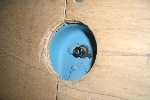
Oddly enough, I didn't worry at all. Earlier on I had been quite concerned about all of this. Flying on a cargo plane registered to some strange company in Kazakhstan. Over Cape Horn and one of the worlds most notorious bad weather areas. To land on sheer ice somewhere in the middle of nowhere. With side winds. And so on. But actually being on the plane, I enjoyed it. Though it helped that it was one of the smoothest flights I ever had. No turbulences at all. Everyone just sat there and relaxed, thinking about the next few days.
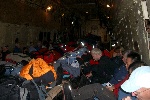
After an hour or so, it was time for catering. No doubt the freshest sandwiches I ever got on
board of an airplane. Sort of like a show restaurant: "See your dishes prepared right in front of you!"
The cargo guy from the plane (no idea what would be the official title of this), Cherry (photographer)
and Andy (guide) were busy cutting salad and tomatoes, preparing sandwiches and feeding the hungry crowd.
This all had a bit of 'feed the animals' time at the zoo, especially when cookies and sweets were
thrown across the length of the aircraft, since all these barrels made movement slightly inconvenient.
A good meal always improves morale, and everyone was pretty happy.
Side remark: Since there isn't much soundproofing in cargo planes, everyone was issued earplugs.
Just in case someone is wondering, why there oddly coloured things in my ear...


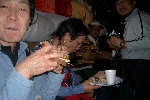
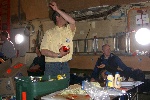
Then things settled down a bit. Some made their bed on the floor, some just stretched out with their feet on the barrels, others just put their sleeping bags on the barrels and slept on top of them. That's when I found out that I can sleep on airplanes. Lying on the metal floor of a cargo plane, wrapped up in a polar parka is really cosy and comfortable. Too bad I'm not likely to fly often like this.
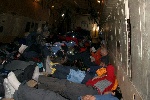
Then, much sooner than expected (we were given a probable flight time of about 4:30 hours and landed after 3:45 hours), we had to get back to our seats and after a bit of rumbling and engine noise - much less than I expected), we were safely down in Antarctica.
Which is maybe a good time to give some information about the 'blue ice runway'. One of the main reasons, why there is the camp at Patriot Hills is the 'blue ice runway'. (There are other places in Antarctica that have those as well, but the one at Patriot Hills is the one nearest to Mt.Vinson, which is the second reason why the camp is there and not somewhere else.)
If you want to bring a reasonable amount of cargo and passengers to Antarctica, you need a wheeled plane. (Which is not quite true. The airplane of choice for Antarctica is a ski-equipped Hercules. But Hercules planes with skis are essentially only available to the US government. If you are a private organization like ANI it is near-impossible to get one. And the Ilyushin is quite a bit larger than the Hercules, which is a big advantage from a logistics standpoint.) Essentially, a wheeled aircraft can not land on a snow runway. So you need something else. Like ice. There are some places in Antarctica, where winds 'falling' down from hills or mountains ('katabatic' winds, a term you hear quite often in Antarctica) blow the snow away and leave only the ice (with a few patches of snow, but they are easily removed).
Which is good, since that's what you need to land a large airplane. But which is also bad, since that means that the place, where you want to land, is a place that is inherently windy. With strong side winds (which are much worse for planes than head or tail winds). So basically the very conditions that let the runway exist are the same that make it unusable most of the time. Additionally, the runway is used mostly in Antarctic summer, when temperatures are 'high' (well, at least by comparison). Which means that on a good flying day (hardly any wind), the ice starts to warm up and gets very slippery. Which is not good for landings. The pilots prefer 'cold' ice. So, not only is the place where you could land the place where the weather often makes landings impossible, but when conditions are good enough for landing for one reason (little wind), this makes it very likely that conditions are bad for landing for another reason (slippery ice). So it seems surprising that they ever land there at all.
But luckily, we did. Time to get out of the plane and enjoy Antarctica.
